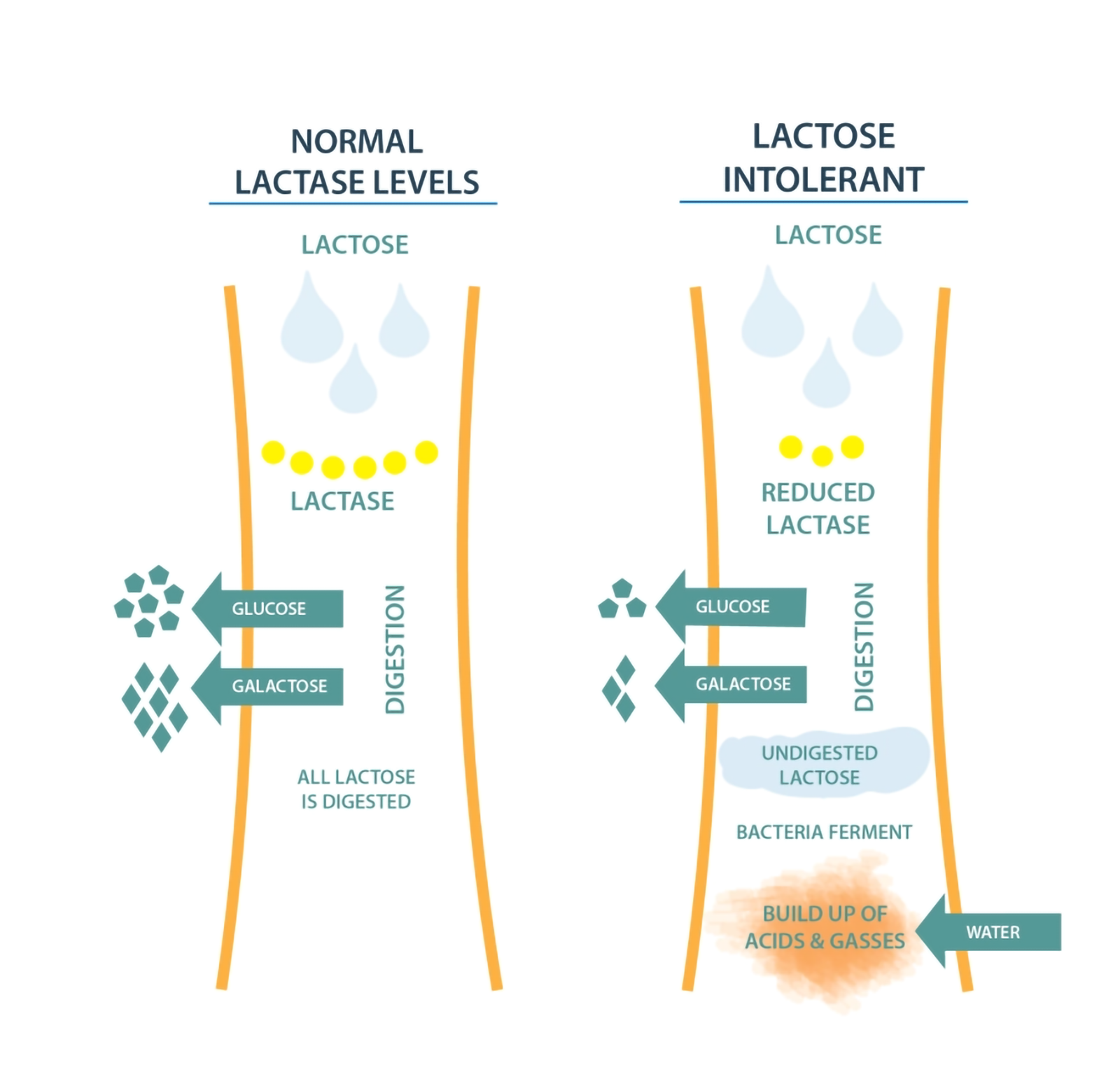Embarking on the journey of diagnosing and managing lactose intolerance involves a comprehensive understanding of this common digestive condition. If you’ve ever experienced discomfort after consuming dairy, a lactose intolerance test may be the key to unravelling the mystery. In this detailed guide, we’ll navigate the signs, symptoms, and treatment of lactose intolerance, as well as practical strategies for creating a fulfilling lifestyle, ensuring that you have all the information you need.
Lactose intolerance is a digestive disorder where the body is unable to fully digest lactose, a complex sugar found in all dairy products. It is caused by lactose malabsorption, which occurs when the body does not produce enough lactase enzymes in your digestive system.
Lactase enzymes play a crucial role in the digestion of foods that contain lactose. The process involves breaking down lactose into simple sugars that can be easily absorbed through the walls in the small intestine and into the bloodstream. Here’s a brief overview of how lactose and lactase enzymes work together:
- Lactose is a disaccharide sugar, meaning it consists of two sugar molecules: glucose and galactose. Lactose is too large to be directly absorbed into the bloodstream through the walls of the small intestine on its own.
- Lactase is an enzyme produced by the small intestine, specifically by cells lining the walls of the small intestine called enterocytes. Lactase breaks lactose down into simple milk sugars (monosaccharides) glucose and galactose which can then be absorbed and provides a source of energy for the body.

The level of lactase enzymes manufactured in the body varies between individuals. In individuals who do not produce enough lactase enzymes, the undigested lactose reaches the colon where it interacts with bacteria, leading to the production of lactic acid and hydrogen gas and causing symptoms such as bloating, flatulence, diarrhoea, and abdominal discomfort known as lactose intolerance.
Understanding the signs of lactose intolerance is fundamental to effectively diagnosing and managing treatment of lactose intolerance and its impact on your daily life.
Lactose Intolerance Symptoms and Diagnosis
Recognising lactose intolerance is the crucial first step in the management process. In this section, we’ll explore the diverse signs and symptoms associated with lactose intolerance, from bloating and gas to abdominal pain and diarrhoea and how to effectively obtain a lactose intolerance diagnosis.
Lactose intolerance signs and symptoms occur after consuming foods that contain lactose. The severity of symptoms can vary from person to person. Common lactose intolerance signs and symptoms include:
Flatulence: The build-up of hydrogen gas in the digestive system can lead to flatulence or passing gas.
Bloating: Excess gas production can also lead to abdominal bloating and discomfort.
Abdominal Pain: Cramping and abdominal pain may occur as a result of the fermentation of undigested lactose by bacteria in the colon.
Diarrhoea: The production of lactic acid can lead to water entering the colon through the gut, leading to diarrhoea.
Nausea: Some individuals may experience feelings of nausea after consuming lactose.
Gurgling or Rumbling Sounds in the Abdomen: The fermentation of lactose by bacteria in the colon can produce audible sounds.
Vomiting (in severe cases): In rare instances, severe lactose intolerance may lead to vomiting.
It’s important to note that these symptoms are not exclusive to lactose intolerance and can be associated with other gastrointestinal conditions. If you suspect you are experiencing lactose intolerance symptoms or experience persistent digestive symptoms, it’s recommended to consult with a healthcare professional for proper evaluation and diagnosis.
It’s also worth mentioning that lactose intolerance is different from a milk allergy. Milk allergies involve the immune system’s response to proteins in milk (such as casein or whey), while lactose intolerance is related to the inability to digest lactose. If you have concerns about your tolerance to lactose or experience symptoms, it’s best to seek guidance from a healthcare provider who can help determine the cause and appropriate management.
Lactose Intolerance Diagnosis
Physicians typically diagnose lactose intolerance through a combination of medical history, symptoms, and specific testing. There are various lactose intolerance tests that can be done including a hydrogen breath test, a lactose intolerance blood test and stool acidity test. The most common lactose intolerance test is the hydrogen breath test. This type of lactose intolerance testing involves the following steps:
Baseline Measurement: A baseline measurement of breath hydrogen is taken.
Lactose Consumption: The person drinks a solution containing a high concentration of lactose.
Monitoring Breath Hydrogen Levels: Breath samples are collected at regular intervals, usually every 15 to 30 minutes, for a few hours after consuming the lactose. The breath samples are analysed for hydrogen content.
Elevated Hydrogen Levels: If the breath hydrogen levels rise significantly above the baseline, it suggests that the lactose was not properly absorbed and has reached the colon, leading to the production of hydrogen gas. Elevated levels of hydrogen in the breath are indicative of malabsorption of lactose and can support a lactose intolerance diagnosis.
An alternative method for lactose intolerance testing is The Lactose Intolerance Blood Test. This comprises a series of blood tests specifically crafted to evaluate blood sugar levels following the intake of a concentrated lactose mixture. Much like the Hydrogen Breath Test, this diagnostic approach is generally withheld from infants and babies to mitigate the risk of triggering severe diarrhoea. In the case of infants and young children, lactose intolerance diagnosis may involve a Stool Acidity Test, wherein the acid levels in a stool sample are measured.
Another lactose intolerance test is to test with lactase enzyme supplements. Many people trial lactase enzyme supplements to see if this reduces or eliminates their symptoms. If symptoms are reduced after taking lactase enzymes it means they are lactose intolerant as the supplements do not assist any other digestive issues apart from lactose intolerance. However, this does not preclude the existence of other digestive issues which a healthcare provider can investigate.
It’s important to note that these lactose intolerance tests are just some methods of diagnosing lactose intolerance, and healthcare providers may consider other factors when making a diagnosis. These include genetics and ethnicity, age, and damage to the small intestines.
Approximately 20% of the Australian population are lactose intolerant, affecting approximately 5% of Caucasians and 65% of non-Caucasians. Lactose intolerance is particularly common among Chinese and other Asian people. Read our comprehensive blog on what causes lactose intolerance.
Managing Lactose Intolerance
An initial reaction to a lactose intolerance diagnosis is often to consider avoiding dairy or foods that contain lactose altogether, known as a lactose free diet or dairy free diet. However, this is not as easy as it sounds – lactose is often a hidden ingredient in foods and is in many medications. Nor is it convenient – going out to eat can become fraught with worry, especially as the symptoms of lactose intolerance can come on quickly and can be embarrassing.
Dairy is also an essential source of calcium in our diets, maintaining bone mineral health, and reducing the risks of osteoporosis. Maintaining dairy in your diet when you are lactose intolerant is achievable by being careful about what dairy products you eat, how much you consume and when. Eating dairy free should be discussed with a healthcare professional to ensure your dairy free diet contains the recommended daily intake of calcium should you choose this option.
How to eat dairy when lactose intolerant
There are various methods and strategies that enable individuals with lactose intolerance to continue enjoying dairy products while minimising or managing symptoms. These approaches focus on improving lactose digestion. By adopting these methods, individuals can maintain a well-balanced diet without compromising their love for dairy or the need for a dairy free diet.
The easiest way to manage your lactose intolerance and eliminate the need to change your diet to only consume lactose free foods is to take lactase pills. Lactase pills are specifically formulated to increase your body’s supply of lactase enzymes, reducing lactose intolerance symptoms.
These pills contain no drugs. There are no lactose intolerance medications that can be used to cure lactose intolerance, although lactase enzymes supplements can significantly reduce or eliminate symptoms. These lactase pills are natural and supplement your body with the lactase enzyme your body is missing.
You simply take lactase pills immediately before consuming dairy. This increases the levels of lactase enzymes in your digestive system and assists the digestion of dairy – allowing you to enjoy dairy without any of the unpleasant symptoms. An alternative method to lactase enzyme pills would be to adjust your intake of foods that contain lactose. You can do this by consuming smaller servings of dairy at a time, eating dairy with other foods and choosing the dairy foods you eat carefully to minimise the lactose load to your body. Use lactose free foods wherever possible. Ensure you eat plenty of calcium-rich, lactose free foods to help maintain your calcium levels. For more information see our tips on how to eat dairy when lactose intolerant to explore these methods in more depth and help minimise lactose intolerance symptoms.
Choosing the Right Lactase Pills
Lactase pills or supplements can be a game-changer for many with lactose intolerance. Lactase pills have been the subject of clinical trials going back 35 years and have been proven to safely reduce the symptoms of lactose intolerance.
In Australia, lactase enzymes are available over the counter as dietary supplements for lactose intolerance. These supplements come in various forms, such as chewable tablets, caplets and drops. One well-known brand that offers lactase supplements in Australia is Lacteeze. Lacteeze is the leading supplier of lactase enzyme supplements in Australia. Lacteeze products are listed with the Therapeutic Goods Association (TGA) and have been available in Australia for over 20 years. Lacteeze has a range of products to suit various tastes and levels of lactose intolerance.
One well-known brand that offers lactase supplements in Australia is Lacteeze. Lacteeze is the leading supplier of lactase enzyme supplements in Australia. Lacteeze products are listed with the Therapeutic Goods Association (TGA) and have been available in Australia for over 20 years. Lacteeze has a range of products to suit various tastes and levels of lactose intolerance.
How does Lacteeze work? Lacteeze tablets and caplets work by supplementing the digestive system with the necessary digestive enzymes to break down lactose into more easily digestible sugars, alleviating symptoms such as bloating, gas, diarrhoea and abdominal discomfort.
By taking Lacteeze tablets before consuming foods that contain lactose, individuals can manage their lactose intolerance and continue to include dairy in their diets avoiding the unnecessary need for a dairy free diet.
It’s important to note that there might be other brands and generic options of lactase enzyme supplements available in Australia as well. These products can be found in pharmacies, health food stores, and in the supplement sections of supermarkets. When purchasing a lactase pill, consider factors such as the product’s strength, form (tablet, caplet, or drops), and any additional features that may suit your preferences.
As with any supplement, it’s recommended to follow the product’s instructions for use, and if you have any concerns or questions, consult with a healthcare professional. They can provide guidance on choosing the right product for your needs and ensure that it aligns with your overall health and dietary requirements.
Understanding, diagnosing, and effectively managing lactose intolerance is different for everyone. Unravelling the mystery of lactose intolerance through diagnostic tests to exploring the signs and symptoms, this guide serves as a resource for those seeking a fulfilling lifestyle while navigating the challenges associated with this common digestive condition.
The relationship between lactose and lactase enzymes highlights the basis of lactose intolerance. Recognising symptoms, such as bloating, gas and abdominal discomfort, is crucial for an accurate diagnosis. A Lactose tolerance test, particularly the hydrogen breath test, is a key diagnostic tool, aiding healthcare professionals in confirming a lactose intolerance diagnosis.
The article emphasises that managing lactose intolerance doesn’t necessarily mean avoiding dairy altogether, which is often the initial reaction. Practical tips for incorporating dairy into the diet offer flexibility and promote a more balanced approach to eating.The inclusion of Lacteeze tablets as a viable solution underscores the role of lactase supplements in alleviating symptoms and enabling you to enjoy dairy without the need for a strict lactose free diet. These are available in all leading pharmacies and supermarkets as well as the Lacteeze online shop.
The inclusion of Lacteeze tablets as a viable solution underscores the role of lactase supplements in alleviating symptoms and enabling you to enjoy dairy without the need for a strict lactose free diet. These are available in all leading pharmacies and supermarkets as well as the Lacteeze online shop.
Ultimately, we hope this guide empowers you by offering practical strategies, dietary tips, and insights into lactase supplements, allowing you to make informed decisions about managing lactose intolerance.






